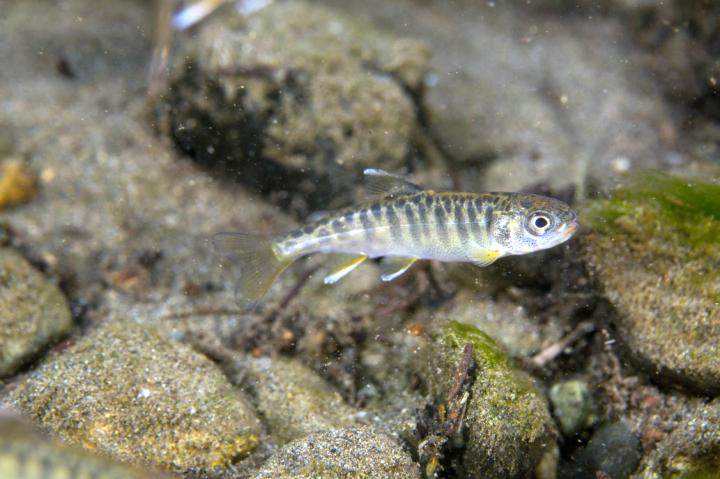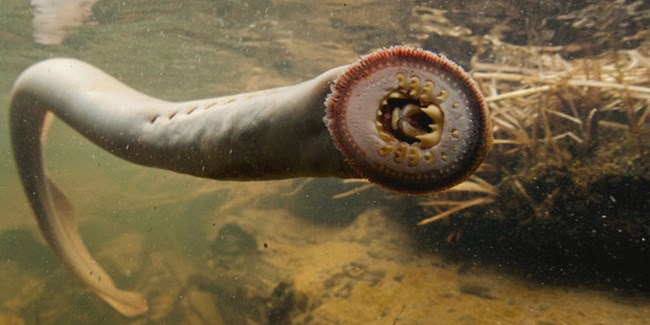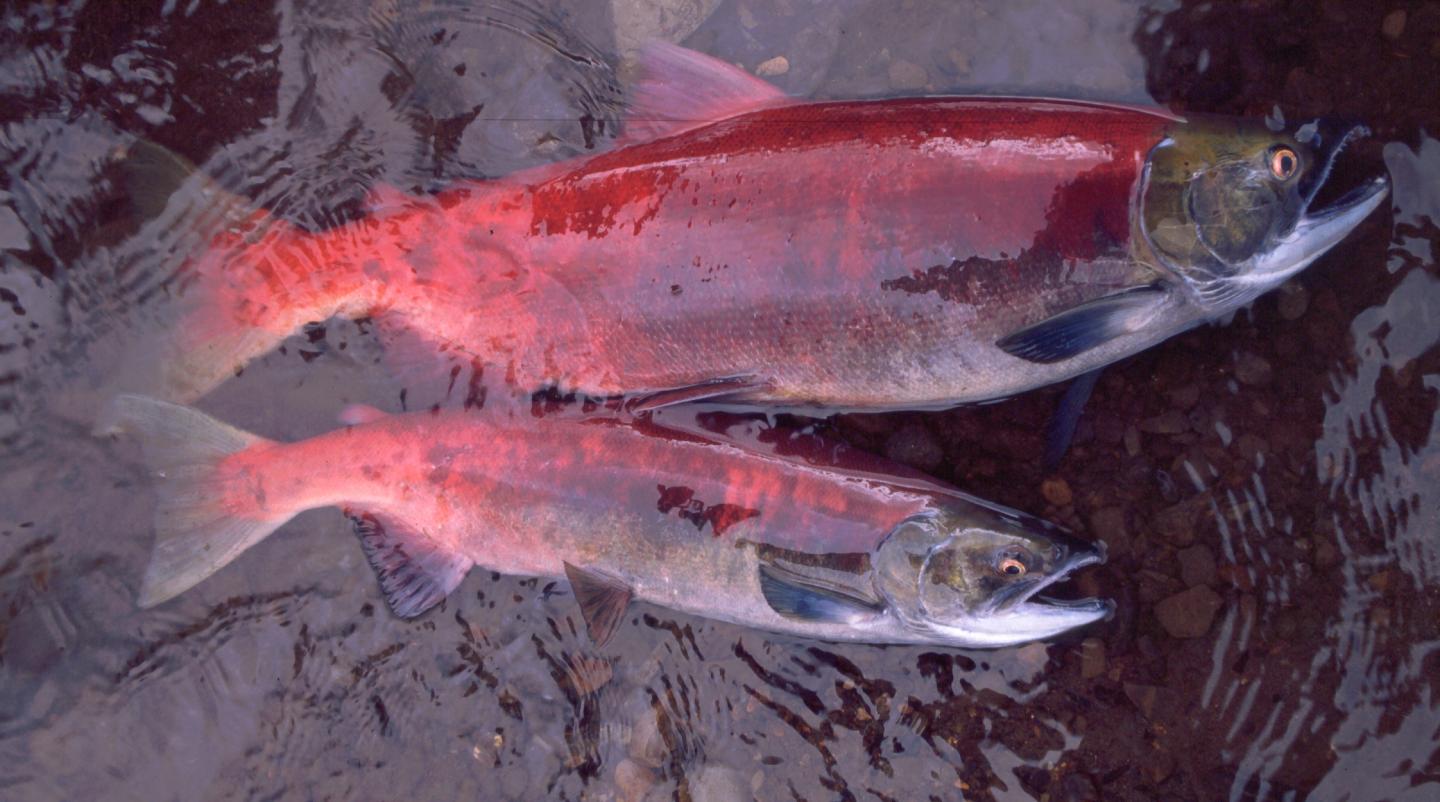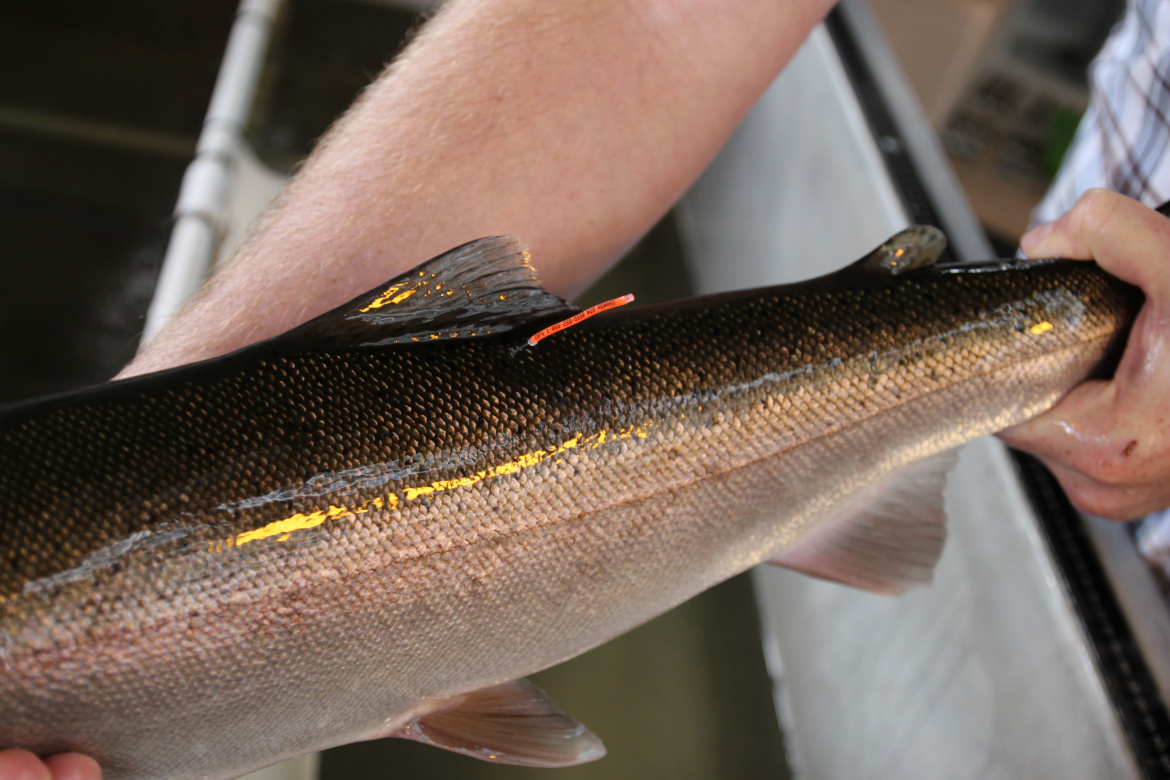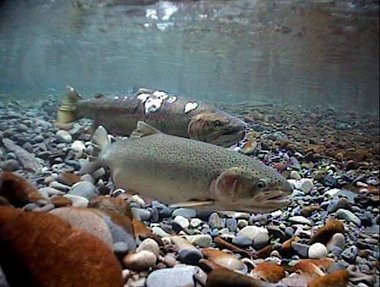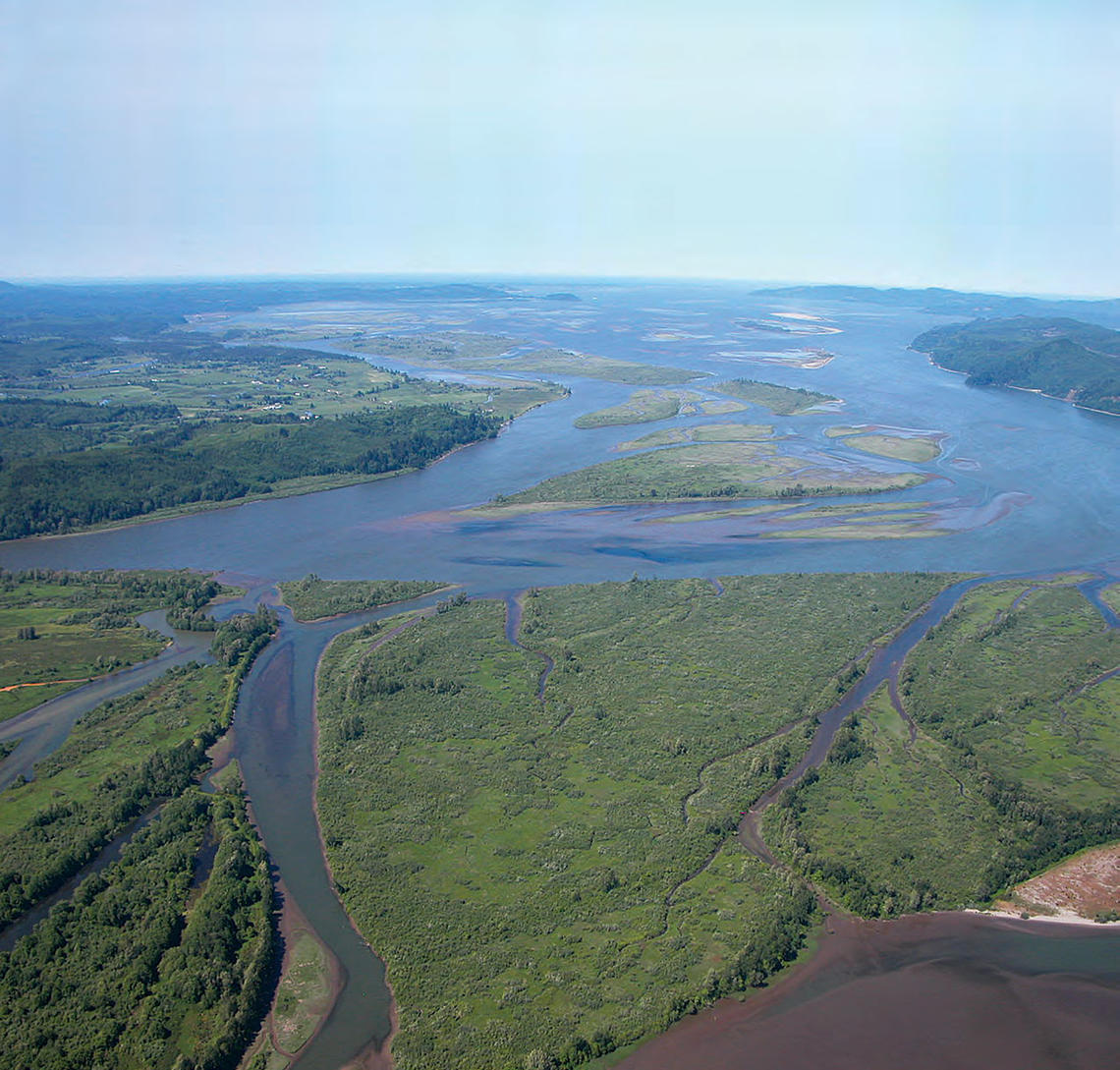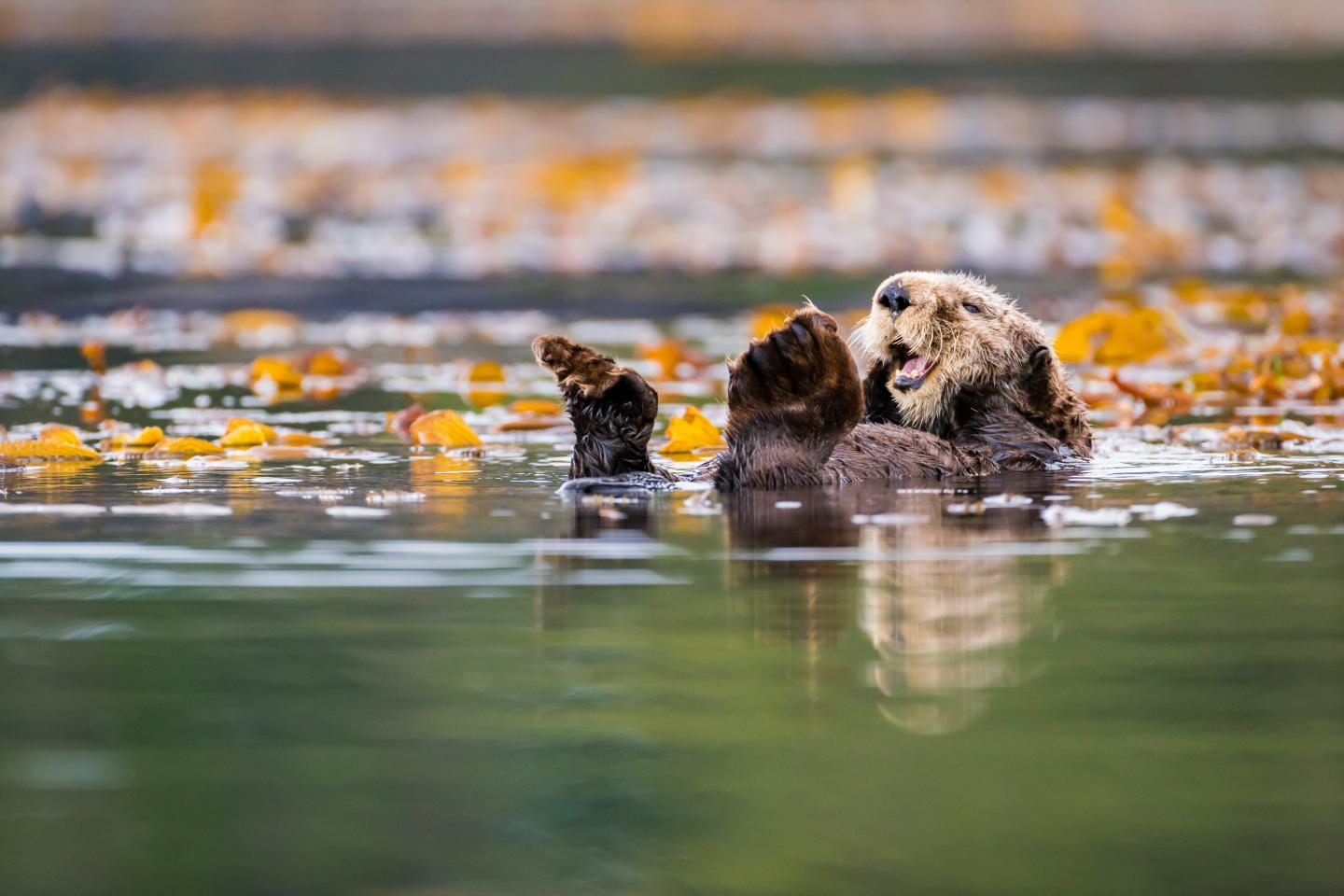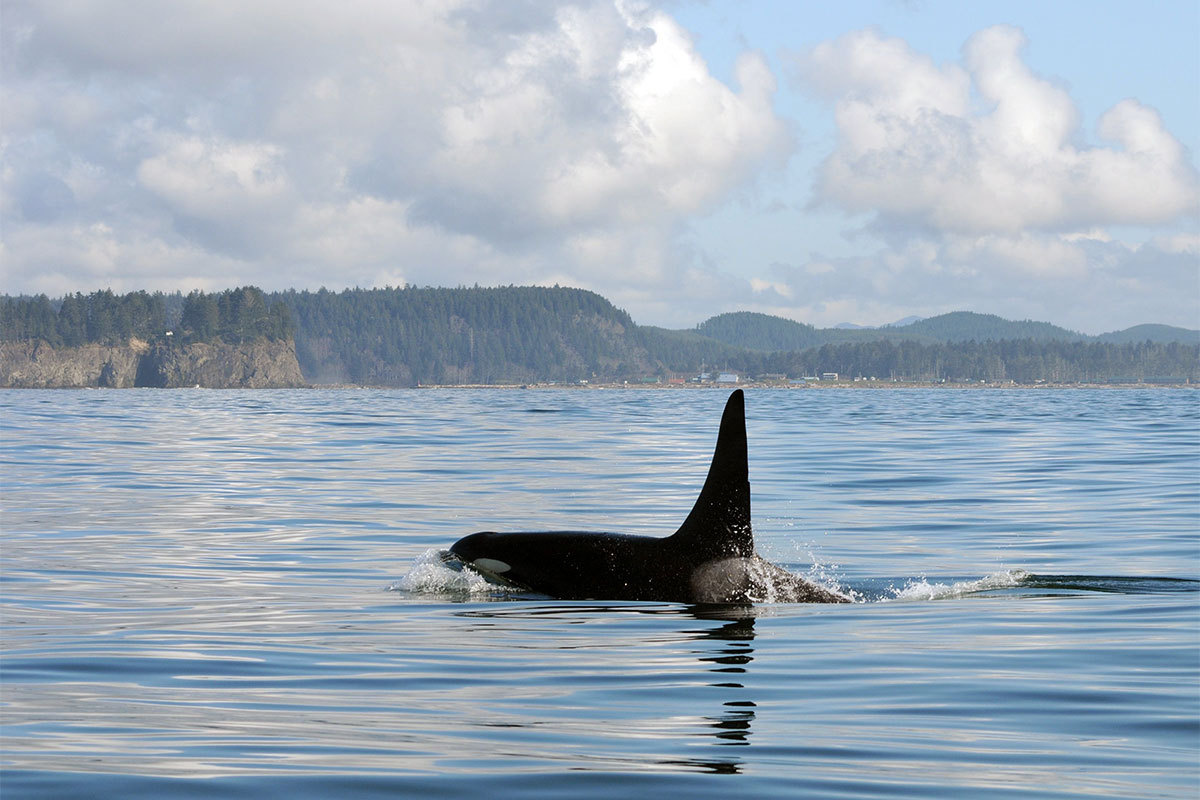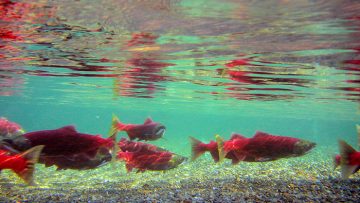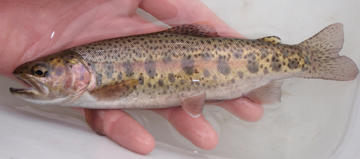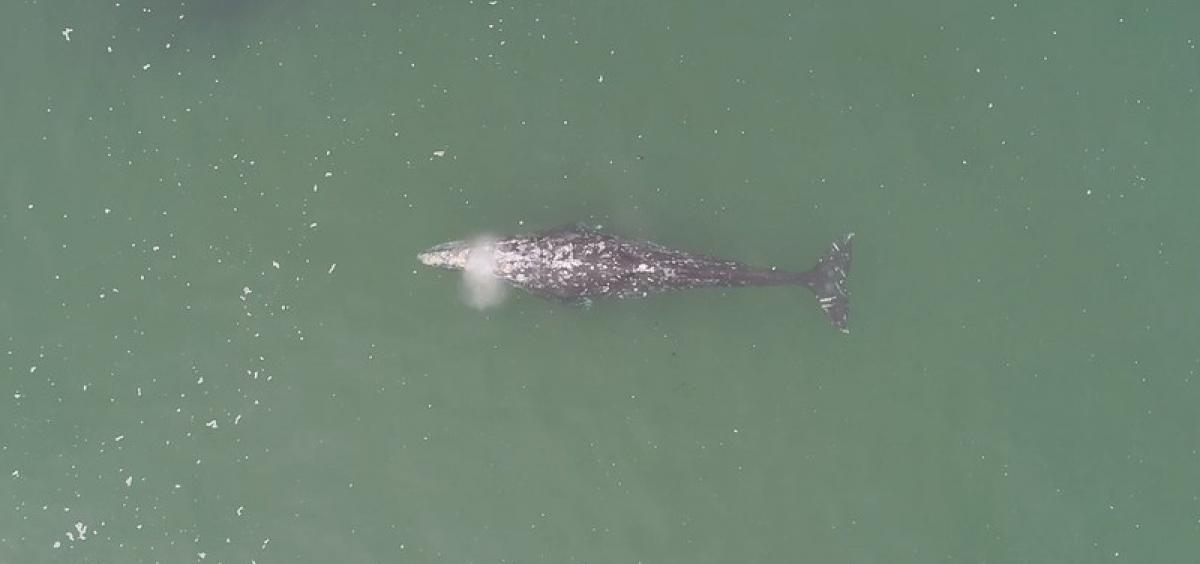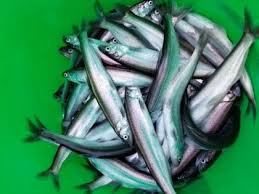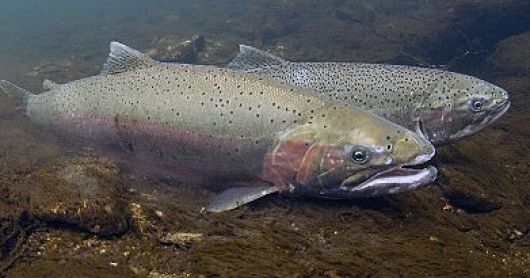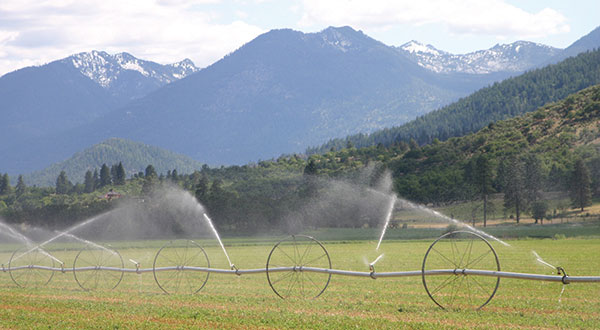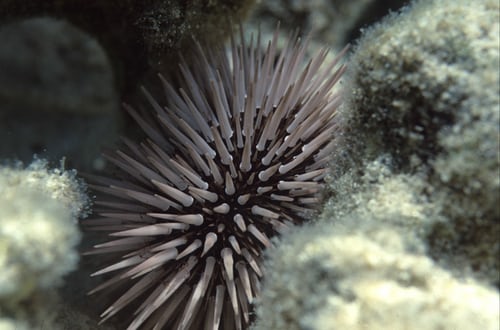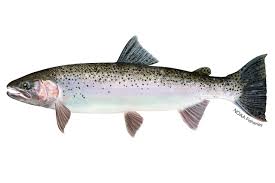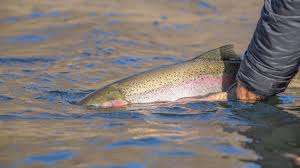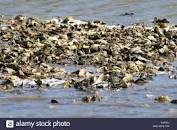Science Panel Would Like To See Fish Passage Center’s Annual Salmon Survival Report Include ‘Impact Report’ Communicating Key Messages
November 12th, 2020
The Fish Passage Center’s annual Comparative Survival Study, providing smolt-to-adult return data and analysis for Columbia/Snake River salmon and steelhead for 25 years, should include an “impact report” to communicate “the most critical take-home messages” for policymakers.
Nuclear War Aftermath: ‘If We Ran Out Of Food On Land, Would We Have Enough Food In Ocean To Feed World’s Population?’
November 12th, 2020
A new study reveals the damage that a nuclear war might take on wild-caught seafood around the world, from salmon and tuna to the shrimp in shrimp cocktails.
Researchers Explore How Ocean Changes Have Led To Thiamine Deficiency Increasing Juvenile Salmon Mortality; Swimming In Corkscrew Patterns
October 30th, 2020
Scientists from several fish and wildlife agencies have launched a rapid research and response effort to tackle a deficiency of thiamine, or Vitamin B1, recently found to be increasing juvenile mortality among chinook salmon in California’s Central Valley.
Spring Chinook, Fall Chinook Different Fish? New Study Says ‘Fundamentally The Same Animal.’
October 30th, 2020
Historically, spring-run and fall-run chinook salmon have been considered as separate subspecies, races, ecotypes, or even as separate species of fish. A new genetic analysis, however, shows that the timing of migration in chinook salmon is determined entirely by differences in one short stretch of DNA in their genomes.
Study: Wild Chinook Spawning Later In A Warming River, While Hatchery Strays Spawning Earlier
September 24th, 2020
Spawn timing for wild chinook salmon in the Skagit River system in Washington is slowly occurring later in the year as the river warms due to climate change, a finding that fits with previous research. However, the trend for hatchery-origin stray chinook salmon in the same river is towards earlier spawning, according to a recent study.
California Steelhead Study Suggests Ocean Migration Timing More To Do With Lengthening Spring Daylight Than Flows
September 17th, 2020
Endangered steelhead in California might use its internal clock to decide when to migrate, according to a study by the University of Cincinnati.
Study Brings Forth Important New Information About Pacific Lamprey Life History Traits, Focus On Adult Body Size, Maturity
August 27th, 2020
Pacific lamprey is a relatively understudied species compared to other anadromous fish, such as salmon and steelhead. Basic biological information has been lacking and there is still uncertainty regarding its life history diversity.
Study Indicates Wastewater Containing COVID-19 Could Be Threat To Natural Water Sources; OSU Gets $1.2 Million Grant To Expand Sewer Surveillance
August 27th, 2020
Wastewater containing coronaviruses may be a serious threat, according to a new, global study led by researchers from the Zuckerberg Institute for Water Research at Ben-Gurion University of the Negev (BGU).
Alaska Salmon Getting Smaller, Returning To Rivers Younger; Climate Change, Competition With Growing Numbers Of Hatchery Fish In Ocean
August 19th, 2020
The size of salmon returning to rivers in Alaska has declined dramatically over the past 60 years because they are spending fewer years at sea, according to a new study led by researchers at the University of California, Santa Cruz, and the University of Alaska Fairbanks.
Study Shows Difficulty Of Predicting Drought In American West, El Nino Cycles Unreliable; Atmospheric Dynamic The Wild Card
August 13th, 2020
People hoping to get a handle on future droughts in the American West are in for a disappointment, as new University of Southern California-led research spanning centuries shows El Niño cycles are an unreliable predictor.
In New Research NOAA Scientists Introduce ‘Thermal Displacement’ Metric Showing How Ocean Heatwaves Shift Habitats
August 6th, 2020
Marine heatwaves across the world's oceans can displace habitat for sea turtles, whales, and other marine life by 10s to thousands of kilometers. They dramatically shift these animals' preferred temperatures in a fraction of the time that climate change is expected to do, new research shows.
Looking For Sources Of Imnaha River Steelhead Mortality, A Discovery: Huge Numbers Of PIT-Tags At Great Blue Heron Rookery
July 30th, 2020
To get a better idea of how much predation plays in steelhead populations, a couple of Nez Perce Tribe Fisheries biologists began looking for clues at a heron rookery on northeast Oregon’s Wallowa River.
Idaho Asks For Anglers Help In Second Year Of Wild Steelhead Study, Provides Data On How Well Fish Survive After Release
July 30th, 2020
To aid a research project, Idaho steelhead anglers are once again being asked to watch for tagged steelhead they might catch during the 2020-21 steelhead fishing seasons, and report tagged fish if they catch one.
How Do Steelhead Build Their Nests? Eavesdropping Seismic Sensors In Washington River Stirs Up Some Answers
July 30th, 2020
Steelhead trout stir up the sediment of the river bed when building their spawning pits, thus influencing the composition of the river bed and the transport of sediment. Until now, this process could only be studied visually, irregularly and with great effort in the natural environment of the fish.
Researcher Says Climate Scientists Ignoring Role Indigenous Peoples Played In Fire, Vegetation Dynamics
July 30th, 2020
In their zeal to promote the importance of climate change as an ecological driver, climate scientists increasingly are ignoring the profound role that indigenous peoples played in fire and vegetation dynamics, not only in the eastern United States but worldwide, according to a Penn State researcher.
Alaska Study Provides First Evidence State’s Chinook Salmon Declines Partly Due To Climate-Driven Changes In Freshwater
July 9th, 2020
A new University of Alaska-led study provides the first evidence that declines in many of Alaska's chinook salmon populations can be attributed in part to climate-driven changes in their freshwater habitats.
Researchers Quantify Relationship Between Caspian Tern Predation Rates On Upper Columbia River Juvenile Steelhead And Returning Adult Fish
July 2nd, 2020
Caspian tern predation on steelhead smolts in the Columbia River has reduced the size of the juvenile migration by more than 20 percent each year also has reduced the number of adult steelhead that return to the river several years later.
Research: Microplastic Pollution Heavily Concentrated In Coastal Habitats, Fjords, Estuaries
July 2nd, 2020
Microplastic pollution in marine environments is concentrated most highly in coastal habitats, especially fjords and estuaries, according to a new review article.
Study Shows Reproductive Potential Of Chinook Salmon Reduced 24-35 Percent As Returning Fish Younger, Smaller
June 25th, 2020
Adult chinook salmon are returning from the ocean to rivers along North America’s West Coast at younger ages and smaller sizes (about 5 to 8 percent in the Yukon River) since the 1970s. The smaller size is resulting in a drop in reproductive potential for female salmon by 24 to 35 percent, based on total egg mass per female, according to a recent study.
Research: Fish Exposed To Chemicals In Waterways Pass On Impacts To Future Generations
June 25th, 2020
Fish exposed to very low levels of chemicals commonly found in waterways can pass the impacts on to future generations that were never directly exposed to the chemicals, according to Oregon State University researchers.
Vancouver Island Sea Otter Recovery; Study Shows Financial Benefits, Ecological Changes Benefitting Salmon
June 18th, 2020
Since their reintroduction to the Pacific coast in the 1970s, the sea otters' rapid recovery and voracious appetite for tasty shellfish such as urchins, clams and crabs has brought them into conflict with coastal communities and fishers, who rely on the same valuable fisheries for food and income.
Wyoming Study Shows Impacts Of Climate Change On Migrating Deer; Alters ‘Green Wave’ Across Landscape
June 18th, 2020
When drought reshuffles the green-up of habitats that mule deer migrate across, it dramatically shortens the annual foraging bonanza they rely on.
Study Looks At Nutritional Value Of Zooplankton For Juvenile Salmon Off BC Coast; Climate-Driven Changes Important Factor
June 12th, 2020
There is truth in the saying "you are what you eat"; even more so if you are a salmon or herring swimming off the British Columbia coast, a recent University of British Columbia study discovered.
Southern Resident Killer Whales: NOAA Researchers Look At Genetic Influence Of Missing ‘Mega-Father,’ Risk Of Increased Inbreeding
June 4th, 2020
The Center for Whale Research reported in January 2020 that L41, also known as “Mega”, is missing from L-pod -- one of three family groups of the endangered Southern Resident Killer Whales.
Ocean Warming, Hatchery Fish Crowding In North Pacific Reducing British Columbia Sockeye Survival
May 29th, 2020
The northeast Pacific Ocean from the Fraser River to the Bering Sea is warming, but it is also becoming more crowded with hatchery pink and chum salmon produced in Alaska and Russia. The competition for food by hatchery pink salmon in a warming ocean has resulted in a 15 percent drop in survival of sockeye salmon returning to the Fraser River and other streams in British Columbia, according to a study released this week.
Study Looks At Impact Of Warmed California Current On Diet/Growth Of Columbia River Steelhead; Longer, Thinner Fish
May 29th, 2020
Ocean temperatures that in 2015 and 2016 were abnormally warm – at times more than 2.5 degrees Celsius higher than normal – stressed juvenile steelhead just entering the California Current and impacted their size and condition. Most of the change occurred in the first few days after ocean entry, according to a recent study.
Grant PUD Study Looks At Stray Rates Of Natural Origin Salmon/Steelhead In Upper Columbia River Basin
May 21st, 2020
A recent study found that the stray rates of returning natural origin salmon and steelhead in the upper Columbia River basin differ by river basin, sub-basin and by stream, with the larger the area the lower the straying percentage.
Increasing Aridity Clear Trend Across The West; Declining Flows, Drier Soils, Tree Death, Stressed Crops, Wildfires, Protracted Drought
May 21st, 2020
Discussions of drought often center on the lack of precipitation. But among climate scientists, the focus is shifting to include the growing role that warming temperatures are playing as potent drivers of greater aridity and drought intensification.
OSU Study Shows Salmon Use Microscopic Magnetite Crystals In Tissue As Map, Compass
May 8th, 2020
Researchers in Oregon State University's College of Agricultural Sciences have taken a step closer to solving one of nature's most remarkable mysteries: How do salmon, when it's time to spawn, find their way back from distant ocean locations to the stream where they hatched?
Independent Science Panel Stresses Need For Analysis Of Climate Change Impacts On Basin Salmon Survival
May 8th, 2020
A science panel says a key ongoing salmon survival study should better take into account potential impacts of climate change on future flows and environmental conditions in the Columbia/Snake river basin.
Focused On West Coast California Current System, Researchers Develop Method To Forecast Ocean Acidity Up To 5 Years In Advance
May 8th, 2020
University of Colorado researchers have developed a method that could enable scientists to accurately forecast ocean acidity up to five years in advance. This would enable fisheries and communities that depend on seafood negatively affected by ocean acidification to adapt to changing conditions in real time, improving economic and food security in the next few decades.
OSU Monitoring Of Oregon’s Gray Whales Shows Changes In Health Related To Ocean Conditions, Poor Upwelling
May 1st, 2020
Three years of “health check-ups” on Oregon’s summer resident gray whales shows a compelling relationship between whales’ overall body condition and changing ocean conditions that likely limited availability of prey for the mammals, a new study from Oregon State University indicates.
Weak Winds Drove 2019 Marine Heat Wave In North Pacific; As If Ocean Stuck Outside On Hot Day With No Wind To Cool It Down
April 23rd, 2020
Weakened wind patterns likely spurred the wave of extreme ocean heat that swept the North Pacific last summer, according to new research led by the University of Colorado Boulder and the Scripps Institution of Oceanography at the University of California San Diego.
Study Looks At Movement of Plastic Through Urban Watershed And Impacts Of Ingestion By Fish
March 26th, 2020
In a sampling of fish from a creek that flows into San Diego Bay, nearly a quarter contain microplastics, according to a new study published in the journal PLOS ONE. The study, which examined plastics in coastal sediments and three species of fish, showed that the frequency and types of plastic ingested varied with fish species and, in some cases, size or age of fish.
Good Columbia River Return For ESA-Listed Smelt This Year; Researchers Learning More On Spawning Activities
March 19th, 2020
Once the run is complete, a biologist with the Washington fishery department said that some 7.5 million pounds of eulachon, also known as Pacific smelt, will have entered the Columbia River. That’s 3 million pounds more than showed up in 2019.
Study Looks At How Retreating Glaciers In Western North America Will Impact Salmon Populations; Some May Benefit
March 12th, 2020
A new Simon Fraser University-led study looking at the effects that glacier retreat will have on western North American Pacific salmon predicts that while some salmon populations may struggle, others may benefit.
Idaho Study Seeks Insights Into Physiological Conditions Necessary For Female Steelhead To Spawn Second Time
March 5th, 2020
The physical condition of a female steelhead at its first spawning can predict the ability of the fish to spawn a second time a year later, according to a recent study that measured body chemicals and condition in female hatchery fish.
Study Says Irrigation Of Cattle Feed Crops Single Largest Consumptive Use Of Water, 32 Percent In Western U.S.
March 5th, 2020
Across the globe, humans are using freshwater resources faster than those resources can be naturally replenished. In the Western United States, for example, water extractions from the Colorado River have exceeded total river flow, causing rapid depletion of water storage reservoirs. In addition, as these water sources dry up, species of fish, plants and animals are also adversely impacted.
Researchers Put Seed Clouding To The Test In Idaho’s Payette Basin; Produced Snow For 67 Minutes
February 27th, 2020
For the first time, researchers have used radar and other tools to accurately measure the volume of snow produced through cloud seeding.
Trophic Cascade: Warm Ocean, Sea Star Wasting Disease, Sea Urchin Explosion, Ravaged Kelp Forests Off California, PNW Coasts
February 13th, 2020
In 2014, a disease of epidemic proportions gripped the West Coast of the U.S. You may not have noticed, though, unless you were underwater.
Study Finds 1-Year Hatchery Steelhead Males More Spawning Success Than 2-Year; Info Helps Optimize Rearing Strategies
January 30th, 2020
Steelhead reared in a hatchery for one year consistently outperformed males reared in the hatchery for two years when competing for spawning opportunities, although one and two year old female steelhead did not differ in their ability to produce offspring, according to recent study.
Study: Willamette Reservoirs Producing Much Larger Salmon Smolts Than Streams; New ‘Grow Chinook’ Model
January 9th, 2020
Chinook salmon smolts that rear in upper Willamette River reservoirs grow much faster and are larger than their counterparts that rear in streams, according to a recent study.
Study Offers ‘Lessons Learned’ From Washington Salmon Recovery Funding Board Habitat Restoration Monitoring
December 12th, 2019
A large-scale and long-term monitoring of habitat restoration projects in the state of Washington found that the size and depth of pools created by the restoration projects failed to fully remain in place after year 10 at 23 monitored projects.
Idaho Fish And Game Staff Honored For Research On Effects Of Catch-Release On Fish
November 27th, 2019
The Association of Fish and Wildlife Agencies recently honored Idaho Fish and Game with the Ernest Thompson Seton Award for the agency’s research on the effects of air exposure on caught-and-released fish.
Study Looking At 65 Years Of Puget Sound Hatchery Practices Questions Trend Toward Releasing Larger Juvenile Fish
November 21st, 2019
A recent study examining salmon hatchery operations practices in the Salish Sea (Puget Sound) in Washington State for the past 65 years finds that current practices are releasing juvenile salmon at a larger size than in the past – a size preferred by predators – and with decreasing diversity. It calls for a consideration of modifying hatchery programs to allow for more diversity by reducing this size homogenization.
Walleye Study Suggests Climate Change Should Prompt New Ways To Manage Inland Recreational Fisheries
November 20th, 2019
There's a long-standing belief in the freshwater fishing community that once anglers find it too hard to land a particular fish for their dinner plate, they either move on to fishing for different species or fish in new waters, giving depleted populations time to rebound.
NOAA Fisheries Study Suggests Fish Size Affects Snake River Salmon/Steelhead Survival More Than Route Through Dams
November 14th, 2019
The survival of juvenile Snake River salmon and steelhead and their eventual return to spawning streams as adults depends more on the juveniles' size than the way they pass through hydroelectric dams on their migration to the ocean, new research shows.
Study: Laundered Clothes Bringing Microplastics To Oysters, Clams On Oregon Coast Through Wastewater
November 13th, 2019
Tiny threads of plastics are showing up in Pacific oysters and razor clams along the Oregon coast -- and the yoga pants, fleece jackets, and sweat-wicking clothing that Pacific Northwesterners love to wear are a source of that pollution, according to a new Portland State University study.
Science Panel Completes Review Of Report On Feasibility Of Reintroducing Anadromous Salmonids Above Grand Coulee Dam
November 7th, 2019
A panel of scientists completed a review of the Upper Columbia United Tribes’ phase 1 report that describes the feasibility of reintroducing salmon and steelhead into the reaches of the Columbia River upstream of Chief Joseph and Grand Coulee dams.
Grande Ronde River Study Shows How Adding Fish Carcasses (With Eggs) Improves Juvenile Salmon,Steelhead Growth Rates
November 7th, 2019
The addition of steelhead carcasses to tributaries of the Grande Ronde River in northeastern Oregon resulted in short-term increases in the growth rates, body condition and size of juvenile chinook salmon and steelhead, factors that may contribute to their survival, according to a recent study.
Middle Fork Salmon River: ‘Shifting Baseline Syndrome’ Skews Wilderness River’s True Abundance Potential For Spring/Summer Chinook
October 31st, 2019
Natural abundance potential of spring/summer chinook salmon in the Middle Fork Salmon River of Idaho recalculated by three biologists is far higher than most current management goals for the fish by NOAA Fisheries, the Nez Perce Tribe and the Idaho Department of Fish and Game, according to a recent study.
Tags, Antennas Tracking Juvenile Salmon In Lemhi, Salmon Rivers To Estimate Travel Times, Survival
October 31st, 2019
Anglers fishing the upper Salmon River this fall and winter may notice large antennas in various locations near the riverbank.
NOAA Identifies New Pacific Subspecies Of Fin Whale; 14,000-18,000 Whales Part of New Designation
October 31st, 2019
New genetic research has identified fin whales in the northern Pacific Ocean as a separate subspecies, reflecting a revolution in marine mammal taxonomy as scientists unravel the genetics of enormous animals otherwise too large to fit into laboratories.
Study Looks At How ‘Climate Reshuffling’ Since 1980s Has Impacted Salmon Productivity In Alaska, B.C., Washington
October 3rd, 2019
Traditionally it was thought that warm coastal water temperatures in Alaska were considered beneficial for salmon productivity, while the opposite was true off the coasts of British Columbia and Washington State where warmer temperatures were not as good for salmon.
Did 1964 Alaska Earthquake, Tsunamis Lead To Mysterious (Sometimes Fatal) Tropical Fungal Outbreak In Pacific Northwest?
October 3rd, 2019
The Great Alaskan Earthquake of 1964 and the tsunamis it spawned may have washed a tropical fungus ashore, leading to a subsequent outbreak of often-fatal infections among people in coastal regions of the Pacific Northwest, according to a paper co-authored by researchers at the Johns Hopkins Bloomberg School of Public Health and the nonprofit Translational Genomics Research Institute.
Groups Petition To ESA-List Oregon Coast Spring Chinook, Say Distinct From Fall-Run Chinook
September 26th, 2019
Three conservation organizations this week petitioned NOAA Fisheries to list spring chinook salmon along much of the Oregon Coast south of the Columbia River as threatened or endangered under the Endangered Species Act.
Council Reduces Science Review Panel’s (ISAB) Budget, Says No Impact To Work: Cost Savings Might Go To Pike Suppression
September 19th, 2019
The annual budget for a panel of scientists that review fish and wildlife projects and regional research issues was cut by almost $200,000 by the Northwest Power and Conservation Council at its meeting in Corvallis, Sept. 18, and the cost savings could be used for Northern pike monitoring and suppression, according to Council staff.
NOAA Fisheries Proposes Expanding Critical Habitat For Killer Whales From Washington To California; New Details On Eating Columbia River Fish
September 19th, 2019
NOAA Fisheries is proposing to expand critical habitat for Southern Resident killer whales along the West Coast, based on information about their coastal range and habitat use.
UBC Study: New Technology Allows World’s Fishing Fleets To Double Fish Capacity, Often Ignored By Fisheries Managers
September 18th, 2019
Technological advances are allowing commercial fishing fleets to double their fishing power every 35 years and put even more pressure on dwindling fish stocks, new research has found.
Research Collaboration Shows Rapid Decline Of Hoary Bat, Victim Of Wind Power, In PNW; Provides Pollination, Pest Control
September 11th, 2019
The hoary bat, the species of bat most frequently found dead at wind power facilities, is declining at a rate that threatens its long-term future in the Pacific Northwest, according to a novel and comprehensive research collaboration based at Oregon State University – Cascades (Bend).
Study Stresses Importance Of Prey Availability For Coho Smolts As Streams Warm
September 11th, 2019
To a certain extent, coho salmon smolts can withstand temperatures somewhat higher than previously thought to be optimal for survival and growth, and, in fact, will even grow faster and larger in higher temperatures, although survival may drop. However, the important variable in their growth over summer periods is the availability and abundance of invertebrate prey for the young salmon to eat, according to a recent study.
British Columbia Study Finds New Viruses In Wild Pacific Salmon Populations; Screened 6,000 Wild, Hatchery, Farmed Salmon Along B.C. Coast
September 5th, 2019
Three new viruses—including one from a group of viruses never before shown to infect fish—have been discovered in endangered chinook and sockeye salmon populations.
Portland State Study Estimates Decline In PNW Average Snowfall Frequency Due To Global Warming
September 3rd, 2019
With warming temperatures, average snowfall frequency is estimated to decline across the Pacific Northwest by 2100 -- and at a faster rate if greenhouse emissions are not reduced, according to a new Portland State University study.
Study Suggests Solar/Photovoltaic Arrays Could Replace Hydro Power, Use Less Land, Boost Fish Runs
August 28th, 2019
In what the lead author says is a “thought experiment,” a new study says that solar and photovoltaic arrays – many on the site of former dams – could produce enough power to replace most hydroelectric dams in the United States, giving salmon, sturgeon, shad and other fish runs unimpeded access to spawning grounds.
Study Shows How Glacier-Fed Rivers Consuming Carbon Dioxide From Atmosphere
August 27th, 2019
Glacier-fed rivers in northern Canada may be consuming significant amounts of carbon dioxide from the atmosphere, according to new research by University of Alberta biologists.
Repeat Steelhead Spawners (Kelts): University of Idaho Study Looks At Differences In Consecutive Spawning Vs. Skip Spawners
August 8th, 2019
Steelhead repeat spawners, known as kelts, grow quickly with greater blood fat levels soon after their first spawning, a signal that they will repeat spawning in the first year, according to a recent study.
Researchers Use ‘Fish Body Double’ To Test Screens Providing Safe Downstream Fish Passage At Oregon Irrigation Structures
August 1st, 2019
Irrigation diversions move some water into a canal or pipeline where it can be used for irrigation, but they pose challenges for fish due to changes in water flow, damaged habitats, and blocked migration routes. A specific concern are the millions of fish that could be “entrained” or travel into a harmful environment and outside the natural flow of water because of such structures.
Study Investigates Reasons For Straying Of Hatchery Fish In Coastal River; Lack Of Unique Odor Cue Cited
July 23rd, 2019
Hatchery females and larger chinook salmon are less likely to return to their hatchery of origin than they are to spawn naturally with wild fish in the Elk Creek basin on the Oregon Coast, even as smaller chinook and males tend to return to the hatchery, according to a recent study.
Council Recommendations For 48 Fish/Wildlife Projects, $43 Million A Year, Out For Public Review
July 18th, 2019
Some 48 fish and wildlife projects that will cost $43.5 million each year – hatchery work, data management, research -- were reviewed and approved by the Northwest Power and Conservation Council’s Fish and Wildlife Committee at its meeting this week in Butte, Montana.
Recreational Fishery Dynamics: Study Shows Connections Among Fish Populations, Angler Behavior, Management Interventions
July 17th, 2019
A recent study combined ecological analysis with the social sciences, identifying a critical link between fish abundance, angler behavior and management actions.
Managing Drought: Oregon Study Says Water Conservation Often Does Not Occur In Right Places At Right Times
July 15th, 2019
In Oregon’s fertile Willamette River Basin, where two-thirds of the state’s population lives, managing water scarcity would be more effective if conservation measures were introduced in advance and upstream from the locations where droughts are likely to cause shortages, according to a new study.
Study: As Regional Climate Warms, Smallmouth Bass Will Encroach On Much More Salmonid Spawning, Rearing Habitat
July 11th, 2019
Nearly 18,000 river kilometers (11,185 miles) of Columbia River basin streams currently has suitable habitat for an invasive predatory fish that, as climate warms, is a range that is predicted to increase by 10,000 river miles by 2080, according to a recent study.
Study: Interpretation Of Historical Salmon Abundance Based Solely On Landings (Harvest) Data Unreliable
June 26th, 2019
Oregon has overestimated the historical number of coho salmon that ultimately spawned in coastal streams, according to the conclusions of a recent study, and it is likely that the number of coho spawning in Columbia River basin streams has also been overestimated.
New Study Shows How Ocean Currents Connect World’s Fisheries Into A Single Network; More International Cooperation Needed
June 25th, 2019
A new study finds that the world's marine fisheries form a single network, with over $10 billion worth of fish each year being caught in a country other than the one in which it spawned.
Hatchery Vs. Wild: Steelhead Study Explores Influences Of Hatchery Environment When Genetics Equal
June 20th, 2019
Recently completed research is throwing light on why steelhead with seemingly identical genetic makeup – hatchery produced and natural populations – perform differently in the wild, impacting lifetime fitness.
Research: With Climate Change Alaska’s Sockeye Head To Ocean Earlier, Face Competition In North Pacific With 6 Billion Hatchery Fish
June 4th, 2019
An ample buffet of freshwater food, brought on by climate change, is altering the life history of one of the world’s most important salmon species.
Salmon Predation Questions: Scientists Say Inevitable Voracious, Invasive Pike Will Move Downstream Of Grand Coulee
May 14th, 2019
Washington tribes and state government first detected the presence of northern pike in Lake Roosevelt, the huge reservoir created by Grand Coulee Dam, in 2007 and have ramped up suppression efforts in the lake since 2014.
First Documented Evidence Of Transoceanic Migration Of Pacific Lamprey; Bering Sea To Columbia River
May 14th, 2019
Recent research documented transoceanic migration in Pacific Lampreys for the first time, with one tagged lamprey traveling from the Bering Sea to the Columbia River.
Study: One-Third Of World’s Longest Rivers Remain Free Flowing, Even Less Source To Sea Connection
May 8th, 2019
Just over one-third (37 percent) of the world's 246 longest rivers remain free-flowing, according to a new study published in the scientific journal Nature.
IPBES Report:Species Extinction Accelerating, 33 Percent Of Marine Fish Stocks Overharvested
May 7th, 2019
Nature is declining globally at rates unprecedented in human history -- and the rate of species extinctions is accelerating, with grave impacts on people around the world now likely, warns a landmark new report from the Intergovernmental Science-Policy Platform on Biodiversity and Ecosystem Services (IPBES).
Essay: Conservation Decision-Making Should Include Clarity, Transparency, Scientific Integrity
April 30th, 2019
Without sound decision-making, responses to seeming environmental tragedies can often make matters worse, according to ethicists who analyzed a controversial goat removal program on an Australian island.
Study: Federally-Sponsored Research Key In Environmental Rule Making, Stakeholder Debates
April 30th, 2019
Federally-sponsored science plays a more significant role in bringing together stakeholders and facilitating environmental governance debates than all other types of research, according to an international team of researchers.
Study Shows How Heavy Tropical Rains In Southeast Asia Contribute To California Heat Waves
April 17th, 2019
Heavy rain over the Indian Ocean and Southeast Asia and the eastern Pacific Ocean is a good indicator that temperatures in central California will reach 100 degrees in four to 16 days, according to a collaborative research team from the University of California Davis and the Asia-Pacific Economic Cooperation Climate Center in Busan, South Korea.
Report: Ocean Conditions Appear To Be Heading In Right Direction For Improving Salmon-Steelhead Runs
March 15th, 2019
Coastal waters are cooling and attracting higher value, more fat-rich food -- a good sign for salmon, steelhead and ocean predators, such as Orcas -- after several years of unusually warm conditions (2014 – 2016), when the warm water “blob” dominated coastal conditions, according to a report released last week by NOAA Fisheries.
Columbia Riverkeeper Study Analyzes Toxin Levels In Five Columbia River Fish Species
October 3rd, 2014
Findings from tests of five Columbia River fish species “intended for the dinner table” show alarming levels of heavy metals, toxic flame retardants, cancer-causing PCBs, and endocrine disrupting chemicals, according to results of a Phase 2 study, “Is Your Fish Toxic?”

